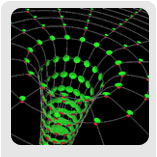 |
 |
The idea of a black hole - an object so massive
that nothing could escape the grasp of its gravity - dates back
to the 1700s. But
the modern story of black holes really starts with Einstein's revolutionary
theory of gravity, completed in 1917. Over the past century,
scientists have used Einstein's theory of gravity to develop a
picture of what black holes must be like. Here are some
of the amazing properties of black holes that they have predicted.
In principle, any object - even a rock - can be made into a black
hole, by squeezing it into a tiny enough volume. Under these
conditions, the object continues to collapse under its own weight,
crushing itself down to zero size. However, according to
Einstein's theory, the object's mass and gravity remain behind,
in the form of an extreme distortion of the space and time around
it. This distortion of space and time is the black hole.
In nature, the only objects that can form a black hole on their
own are large stars - stars several times more massive than our
own Sun. At the end of their lives, these stars collapse
under their own weight, forming a black hole. While the original
star might be millions of miles wide, the resulting black hole
is just a few miles across. The hole itself is shaped like a beach
ball - spherical.
The resulting black hole is the darkest black in the universe:
No matter how powerful a light you shine on it, no light ever bounces
back, because the light is swallowed by the hole. A black
hole is a true "hole" in space: Anything that
crosses the edge of the hole - called the "horizon" of
the hole - is swallowed forever. For this reason,
black holes are considered an edge of space, a one-way exit door
from our universe; nothing inside a black hole can ever
communicate with our universe again, even in principle.
However black holes are even stranger than that. As you get
closer to a black hole, the flow of time slows down, compared to
flow of time far from the hole. (According to Einstein's
theory, any massive body, including the Earth, produces
this effect. Earth's gravity is so weak that the slowing
of time is not noticeable, but the effect has been confirmed using
sensitive instruments. For example, at sea level you age
one-billionth of a second less every year than you would if you
lived on top of Mt. Everest.) Near a black hole, the slowing
of time is extreme. From the viewpoint of an observer outside the
black hole, time stops. For
example, an object falling into the hole would appear frozen in
time at the edge of the hole.
Inside a black hole is where the real mystery lies. According
to Einstein's theory, time and space, in a way, trade places inside
the hole. Inside the black hole, the flow of time itself draws
falling objects into the center of the
black hole. No force in the universe can stop this fall, any more
than we can stop the flow of time.
At the very center of the black hole is where our understanding
breaks down. Einstein's theory of gravity seems to predict
that time itself is destroyed at the center of the hole: time
comes to an abrupt end there. For this reason, a black hole
is sometimes described as the "reverse of creation." But
no one knows how or why time could come to an abrupt end, any more
than we know how time was created in the first place. Einstein's
theory of gravity no longer applies at these tiniest scales of
distance, and new laws of nature must be found that describe what
happens at the center of a black hole.
Does the inside of a black hole lead to another universe, as some
scientists have claimed? The truth is, no one really knows. We
cannot do a direct experiment to find out, even in principle, since
no information or evidence can ever get back out of a black hole.
That's what makes it so important to find and study black holes
from the outside,
while at the same time developing theories that can more confidently
predict what might happen on the inside of the black
hole.
It is one thing to predict what black holes should be like. It
is quite another to hunt for them in nature. Do black holes
really exist? If so, what are they like? Explore the
evidence for black holes in the next
section > |
 |


|